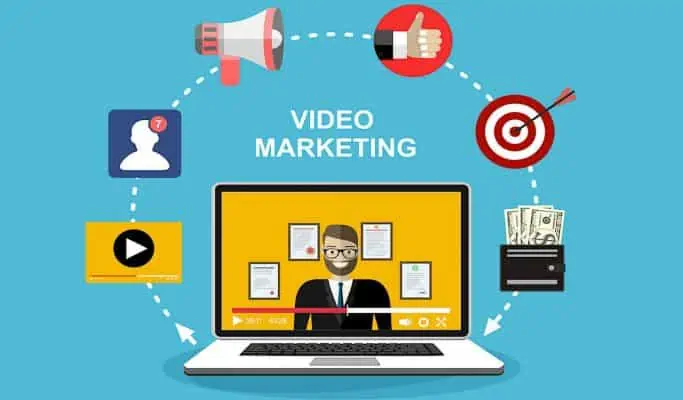
Video marketing is more accessible today than ever. Brands can quickly produce quality content and share it with the world, and tracking and measuring the ROI of your content is possible. This blog post will explore how you can create a powerful video marketing strategy for your brand. We’ll dig into your system, how to create a video marketing funnel, what types of videos your funnel should have, how to create powerful videos, and share tips to share your videos.
1. What is video marketing?
It’s been said that an image is worth a thousand words. For a video, multiply that by another thousand. That is the basis of video marketing, a powerful form that effectively engages your audience as a part of your marketing campaigns.
Video marketing means promoting and telling people about your product or service. It helps increase engagement on your digital and social channels, educates your audience, and allows you to reach them with a new medium.
2. Why is video marketing important?
Using video as part of a marketing campaign is gaining much traction across businesses of all sizes, including entrepreneurs and small businesses.
Renderforest Survey found that videos helped businesses increase:
Brand awareness by 70%
Traffic by 51%
Sales by 34%
The outcome is unique, isn’t it?
The key to their popularity lies in their relative ease of engaging with prospects and clients across multiple platforms.
Small businesses like yours increasingly use videos to attract, convert, and retain new customers with great success.
3. What are the benefits of video marketing?
With access to faster networks, businesses are using more and more videos to engage with their customers. Many companies, probably also your competitors, use videos to help capture value from their audiences.
Why should you use videos in your social media posts? Video posts:
- Stay visible longer on social feeds
- Get more exposure and engagement
- Increase the understanding of your product
- Stand out more
- Provide a more personable way to engage with your audience
- Are powerful sales tool
- Rank higher in search
- Are growing in popularity across platforms
How do you go about creating a video marketing strategy?

Step One: Audit Your Video Content
Performing a video content audit is about understanding what you’ve created and its effectiveness. To start, list your videos and collect metrics for each. For example, if you upload videos to YouTube, go to your creator dashboard and collect stats on video views and engagement. Also, if you have Google Analytics data that attribute site visits to video views, include that.
Next, determine how successful your videos have been. Have they generated as many views as you expected? Which of your videos were most popular? How many hits did your videos bring to your website?
While this is not an exhaustive list of questions, it’s a good starting point. Your goal is to determine what results in your videos have brought your brand. If the results thus far have not been effective, take the time to examine the content you produced. Further, this blog post will show you how to create effective and engaging videos. You can use a three-step formula as a guide and compare how your videos are structured to see where you can improve them.
Step Two: Create a Video Marketing Funnel
Creating a video marketing funnel gives you the chance to plan content. A video marketing funnel includes a collection of videos specially produced to help buyers ultimately become customers. Video marketing funnels are like content marketing funnels. At each stage, they perform specific feats to help move buyers closer to the sale. Video marketing funnels fit into content marketing funnels.
Videos and Funnel Stages
While funnels are not new, they can still be perceived as complex. The good news is video marketing funnels are easy to understand and design. A clear breakdown of how each stage of a video marketing funnel works to power your video marketing strategy follows.
Attract at the Top-of-the-funnel
Videos at your funnel are designed to attract as many buyers as possible. As with the content marketing funnel, these are people who may understand a specific problem they face or need help to define a problem as they become more and more exposed to solutions like yours.
To help, videos you create for the top of your funnel are all about helping strangers better understand their challenges. Here, your videos are educational and focus more on providing clarity or demystifying concepts your audience has been exposed to.
Key Metrics: Video View Count and Engagement
Create videos that generate more views and engagement. The higher your numbers, the better your videos reach more of your target audience.
Most people have heard about QuickBooks. To grab the attention of small business owners, they turned to Danny DeVito. By creating a series of short ads where DeVito touches on some of the most common errors business owners make (trying to run the business and complete the books). The accounting software brand was able to show buyers that there is a more thoughtful way quickly.
Educate at Middle-of-the-funnel
Videos created for the middle of your funnel design to educate your now problem-aware audience. At this stage, your viewers have been exposed to new concepts and challenges and are ready to learn about solutions like yours. Your goal is to share how your solution works and why it fits the brand best. This stage also proves why other solutions are not as effective as yours.
Key Metric: Watch-Time
Watch time shows how much time people spend watching your videos. The longer your watch time, the better. More extended video views prove that people are learning about what your brand has to offer.
Squatty Potty knew that selling its product would require education. So they created this fun but informative video. It explains why you’re pooping incorrectly and how their product can change that and make you healthier.
Convert at Bottom-of-funnel
Videos at the bottom of your funnel are designed to convert educated buyers. You can persuade buyers to take the next step through in-depth looks at your product through demos and powerful social proof content like video case studies and testimonials.
Key metric: Conversions
Conversion can be in sign-ups, leads generated, or sales.
Video demos are powerful. They offer buyers a chance to see your product in action. They also help buyers understand how your product works and whether it will be the right fit for their organization or personal use. Pat Flynn shares why and how he adopted ConvertKit as his email marketing tool of choice.
In this video, Flynn walks viewers through how to apply ConvertKit code to the websites to capture email addresses, how he uses the software, and why he loves it so much. If you’re a marketer looking for a marketing solution, this demo answers all of your questions.
Step Three: Create Engaging Videos

With a good understanding of how to design your video marketing funnel, it’s time to look at creating engaging videos. The most effective videos immediately grab the attention, holding onto it as they progress. And that’s important. If you want your videos to generate results, you need to boost your bottom line. They have vital people tuned in. Here’s a simple three-step formula for creating engaging and compelling videos.
Create a Powerful Hook
A hook is the first sentence or idea you share with an audience. It matters because it has to capture their attention immediately. You aim to get viewers past your video’s first few seconds by identifying a specific point of interest. Hooks can be in the form of a powerful statement or an offer of valuable information that your audience wants to get their hands on.
Hooks can also address serious challenges or pain points that your audience experiences. When creating yours, make sure it’s peculiar and aligned with your audience. This will guarantee that they pay attention and want to learn more.
Deliver Value
There’s a good reason why people click on video thumbnails and start watching videos. It’s got to do with gaining something. That something could be valuable information, new insights, or even a laugh. Whatever your video title and intro promise, you have to deliver.
This idea may seem more challenging for brands selling products and services. How do you begin to quantify what buyers consider “valuable” information? A simple rule of thumb is to put what you have to offer in context. Think about how this information can positively influence your buyer. Does watching a video give them a new perspective? Will they learn something they never knew because the information you share has never been shared?
Close With a Clear and Strong Call to Action
Every marketer knows that using calls to action is vital. They direct buyers on what to do next. And to make your videos as strong as possible, you must include calls to action. But make sure yours are personalized and clearly state the value viewers stand to gain by taking action.
At the end of Uscreen’s video on how to price online courses, viewers are offered the chance to learn more ways to make money from their content. All they need to do is subscribe to the channel. This tactic is a subtle but highly effective way of building a large following on YouTube.
Conclusion
Video is one of the most effective ways to get in front of your buyers today. It’s also easy to start, and all brands should use it. But before you pick up the camera and hit record, take the time to develop an effective video marketing strategy. Design your video marketing funnel, and fill it with engaging videos. Take the time to learn as much as you can about your buyers, too. After all, every video you create will be for them, and your goal is to attract, educate, and convert as many buyers as possible into paying customers.
Private Agent for Dropshipping Success